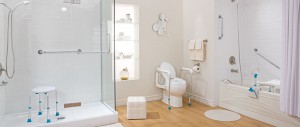Why Bathroom Safety?
Although people are in better health and in better physical condition due to a higher standard of health care services and better information, accidents will always happen and the risk of incidents increase with age.
The bathroom is a very risky environment for injuries and it presents many environmental hazards due to the nature of materials used, the limited space and the close presence of water and electricity. The risk factors have an exponential effect on the likelihood of an incident. The most common incidents are: falls, slips and scalding from hot water.
A momentary lapse in attention, loosing balance, a momentary weakness or diminished flexibility, can be perilous to your safety.
- 48% of all known location of injuries happen in “the home”.
- 2 out of 5 accidents take place in the bathroom.
- 33% of all people over 65 will fall at least once this year.
- 50% of all people over 65 will fall more than once.
- Approximately 75% of falls will result in injury.
Falls are the number one cause and responsible for 74.6% of all accidental injuries for seniors (All ages = 27%) and approximately 80% of all hospital admissions for older Canadians. More than half of all falls will produce soft tissue damage, up to 25% will cause moderate to serious injuries and 20% of all falls will be fatal.
Many non-fatal injuries will result in impairment or disability. It is estimated that 20% of seniors who are hospitalized for an injury are moved to institutionalized care after the incident.
Also, as the duration of hospital stays are minimized, patients are released as quickly as is possible and sent home to heal independently.
Bathroom safety products add confidence; help to prevent some accidents and facilitate physical recovery by minimizing strain.
Source:
- Seniors and Aging – Preventing falls in and around your home (Health Canada, H13-7/10-2006E, 2006)
- Améliorer la sécurité des Ainés au Canada (Public Health Agency of Canada, 2005)
- Rapport sur les chutes des Ainés au Canada (Public Health Agency of Canada, HP25-1/2005F, 2005)
- Health report (Statistics Canada, 82-003, 2002)
- Workshop on Healthy Aging (Public Health agency of Canada, Nov 28-30, 2001)
- CHIRPP database – Summary Statistics (Health Canada, 1999)



